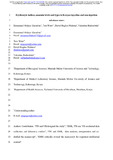Erythrocyte indices, anaemia levels and types in Kenyan injection and non-injection substance users

Date
2018-10-03Author
Mulaya, Khazalwa E
Were, T
Hughes, Mulama D
Budambula, V
Metadata
Show full item recordAbstract
The impact of injection and non-injection substance use in HIV infections is an area of great public importance especially with respect to hematologic and immune profiles. Evaluations of hematologic and immune status are critical for better disease classification and clinical management especially of HIV positive substance users. However, not much information is known about the hematologic and immune derangements in HIV infected injection and non-injection substance users. This study, therefore, aimed at determining the laboratory markers of hematologic and immune derangements in HIV infected substance users. Hematologic and immune profiles were evaluated on venous blood specimens obtained from injection substance users, ISU (HIV-infected, n=62 and -uninfected, n=213) and non-injection substance users (HIV-infected, n=33 and -uninfected, n=186); and non-substance using controls (n=56) from Mombasa, coastal town of Kenya. The prevalence of anemia was higher in HIV infected ISU (48.4%) and non-ISU (63.6%) (p<0.0001); and HIV uninfected ISUs (56.3%) compared to HIV-uninfected non-ISUs (39.2%) and non-substance using controls (28.6%; p=0.0028). Hypochromic anaemia was more prevalent in the HIV-infected ISU (50.0%) and non-ISU (61.9%), and HIV-negative ISU (63.3%) relative to the HIV-negative non-ISU (39.7%) and non-substance using controls (56.3%; p=0.0007). Mild immunodeficiency dominated in the HIV infected individuals (HIV-infected ISU, 32.3% and non-ISU, 21.2%) versus HIV-uninfected ISU (16.9%); non-ISU (12.9%); and non-substance users (14.3%) while severe immunosuppression prevailed in HIV infected substance users (ISU, 14.5% and non-ISU, 15.2%) against HIV uninfected substance users (ISU, 5.2% and non-ISU, 3.8%); thus immunosuppression in substance users is aggravated with HIV infection. Moreover, drug-induced immunosuppression is associated with a higher likelihood of anaemia in HIV-uninfected substance users; ISU (OR=3.95, CI=1.934-8.077, p<0.0001) and non-ISU (OR=3.63, CI=1.571-8.39, p=0.003). Altogether, hypochromic anaemia, normochromic anaemia and CD4+ T-helper cytopenia are the most prevalent hemocytopenias in HIV infected and uninfected injection and non-injection substance users.
URI
https://doi.org/10.1101/434365https://europepmc.org/article/ppr/ppr57532
http://ir-library.mmust.ac.ke:8080/xmlui/handle/123456789/2562
Collections
- Gold Collection [987]
